HONDA ACCORD SEDAN 2007 (in English) Workshop Manual
Manufacturer: HONDA, Model Year: 2007, Model line: ACCORD SEDAN, Model: HONDA ACCORD SEDAN 2007Pages: 293, PDF Size: 5.47 MB
Page 51 of 293
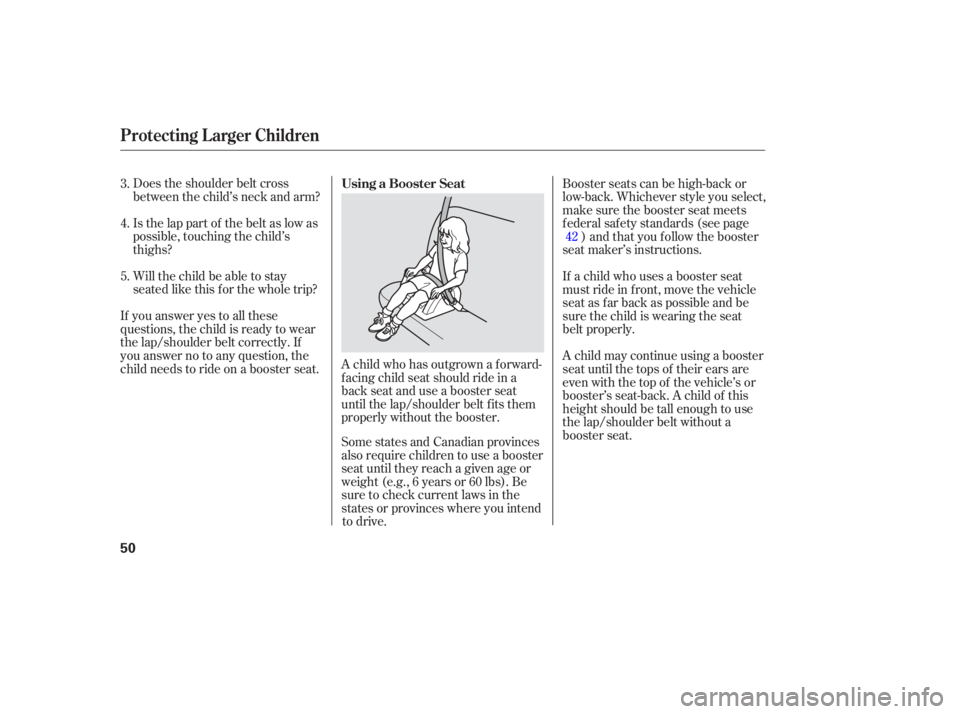
Does the shoulder belt cross
between the child’s neck and arm?
Is the lap part of the belt as low as
possible, touching the child’s
thighs?
Will the child be able to stay
seated like this for the whole trip?
If you answer yes to all these
questions, the child is ready to wear
the lap/shoulder belt correctly. If
you answer no to any question, the
child needs to ride on a booster seat. A
child who has outg rown a forward-
facing child seat should ride in a
back seat and use a booster seat
until the lap/shoulder belt fits them
properly without the booster.
Some states and Canadian provinces
also require children to use a booster
seat until they reach a given age or
we ight (e.g., 6 years or 60 lbs). Be
sure to check current laws in the
states or provinces where you intend
to drive. If
a child who uses a booster seat
must ride in front, move the vehicle
seat as far back as possible and be
sure the child is wearing the seat
belt properly. Booster seats can be high-back or
low-back. Whichever style you select,
make sure the booster seat meets
f ederal saf ety standards (see page ) and that you f ollow the booster
seat maker’s instructions.
A child may continue using a booster
seat until the tops of their ears are
even with the top of the vehicle’s or
booster’s seat-back. A child of this
height should be tall enough to use
the lap/shoulder belt without a
booster seat.
4.
5. 3.
42
Using a Booster Seat
Protecting L arger Children
50
Page 52 of 293

If you decide that a child can safely
ride up front, be sure to:
Carefully read the owner’s manual,
and make sure you understand all
seat belt instru ctions and all safety
info rmation.
Move the vehicle seat to the rear-
most position.
Have the child sit up straight, back
against the seat, and feet on or
near the floor.
Ch eck that the child’s seat belt is
properly and secu rely positioned.
Supervise the child. Even mature
children sometimes need to be
reminded to fasten the seat belts
or sit properly.
Of
course, children vary widel y. And
while age may be one indicator of
when a child can safely ride in front,
there are other important factors you
should consider.
If the passenger’s front airbag
inflates in a moderate to severe
frontal collision, the airbag can cause
serious injuries to a child who is
unrestrained, improperly restrained,
sitting too close to the airbag, or out
of position.
A side airbag also poses risks. If any
part of a larger child’s body is in the
path of a deploying side airbag, the
child could receive possibly serious
injuries. The National Highway Traffic Safety
Administration and Transport
Canada recommend that all children
age 12 and under be properly
restrained in a back seat. Physically, a child must be large
enough f or the lap/shoulder belt to
properly f it (see pages and ). If
the seat belt does not f it properly,
with or without the child sitting on a
booster seat, the child should not sit
in f ront.
To saf ely ride in f ront, a child must
be able to f ollow the rules, including
sitting properly, and wearing the seat
belt properly throughout a ride.4916
Physical Size
Maturity
When Can a L arger Child Sit in
Front
Protecting L arger Children
Driver and Passenger Saf ety
51
Page 53 of 293

This could result
in serious neck injuries during a
crash. Devices intended to
improve a child’s comf ort or
reposition the shoulder part of a
seat belt can make the belt less
ef f ective and increase the chance
of serious injury in a crash.
This could
cause very serious injuries during
a crash. It also increases the
chance that the child will slide
under the belt in a crash and be
injured.
If they do, they
could be very seriously injured in a
crash.
Do not let a child wear a seat belt
across t he neck. Do not put any accessories on a
seat belt.
Do not let a child put the shoulder part of a seat belt behind t he backor under t he arm.
T wo children should never use thesame seat belt .
Additional Saf ety Precautions
Protecting L arger Children
52
Page 54 of 293
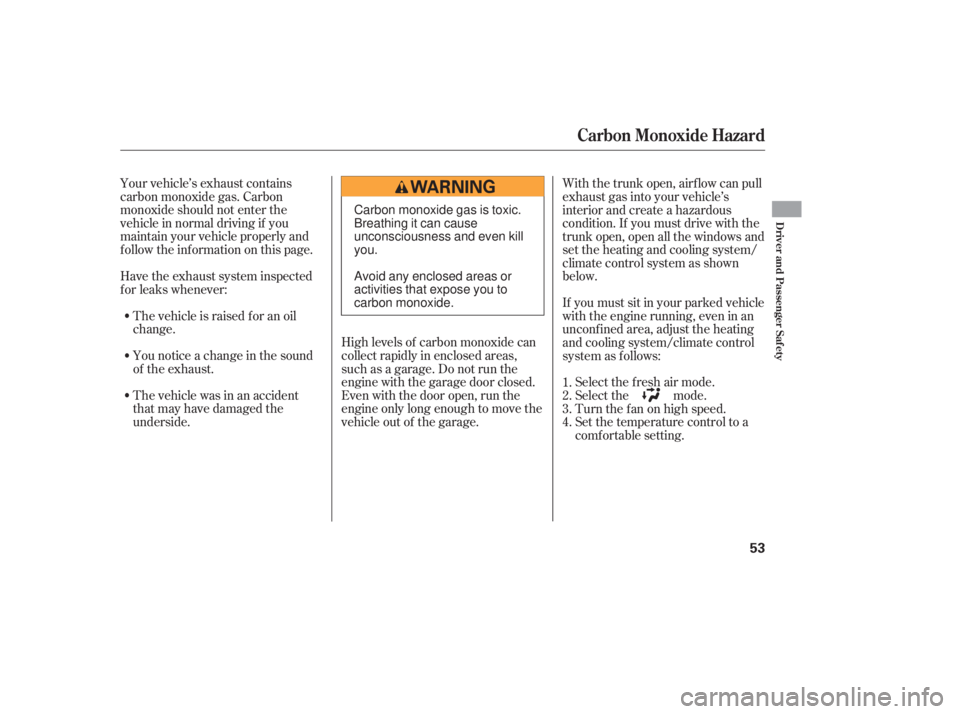
Your vehicle’s exhaust contains
carbon monoxide gas. Carbon
monoxide should not enter the
vehicle in normal driving if you
maintain your vehicle properly and
f ollow the inf ormation on this page.High levels of carbon monoxide can
collect rapidly in enclosed areas,
such as a garage. Do not run the
engine with the garage door closed.
Even with the door open, run the
engine only long enough to move the
vehicle out of the garage.
Have the exhaust system inspected
f or leaks whenever:
The vehicle is raised f or an oil
change.
You notice a change in the sound
of the exhaust.
The vehicle was in an accident
that may have damaged the
underside. With the trunk open, airf low can pull
exhaust gas into your vehicle’s
interior and create a hazardous
condition. If you must drive with the
trunk open, open all the windows and
set the heating and cooling system/
climate control system as shown
below.
Select the f resh air mode.
Select the mode.
Turn the f an on high speed.
Set the temperature control to a
comfortable setting.
If you must sit in your parked vehicle
with the engine running, even in an
unconf ined area, adjust the heating
and cooling system/climate control
system as f ollows:
1.
2.
3.
4.
Carbon Monoxide Hazard
Driver and Passenger Saf ety
53
Carbon monoxide gas is toxic.
Breathing it can cause
unconsciousness and even kill
you.
Avoid any enclosed areas or
activities that expose you to
carbon monoxide.
Page 55 of 293
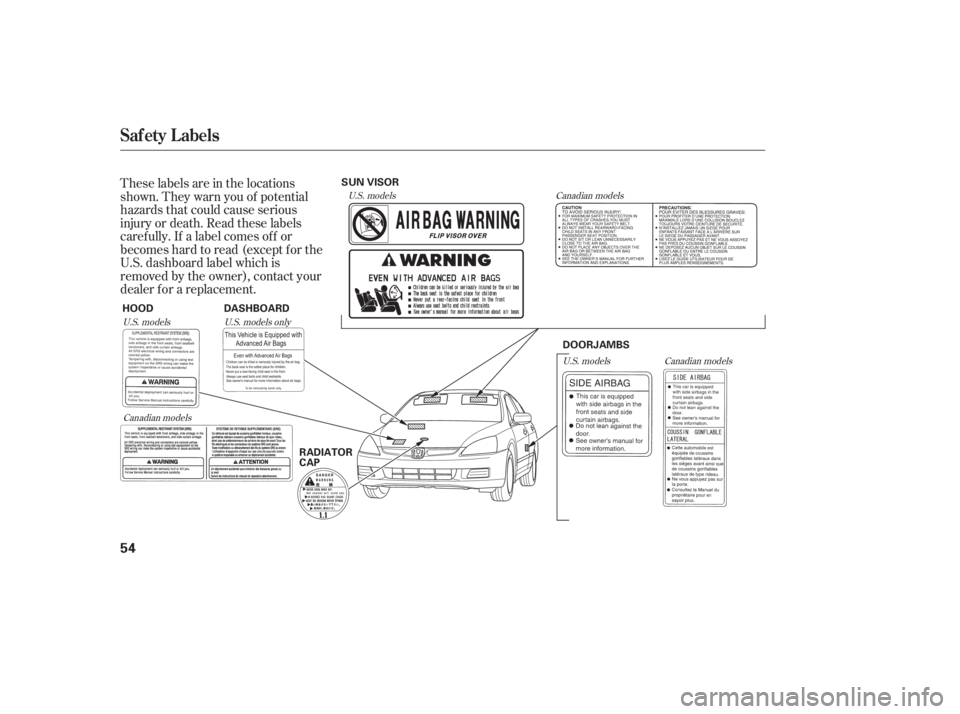
These labels are in the locations
shown. They warn you of potential
hazards that could cause serious
injury or death. Read these labels
caref ully. If a label comes of f or
becomeshardtoread(exceptforthe
U.S. dashboard label which is
removed by the owner), contact your
dealer f or a replacement.
U.S. modelsCanadian models
U.S. models
Canadian models U.S. models only Canadian models
U.S. models
Saf ety L abels
54
SUN VISOR
HOOD DOORJAMBS
RADIATOR
CAP
DASHBOARD
Page 56 of 293

This section gives inf ormation about
the controls and displays that
contribute to the daily operation of
your vehicle. All the essential
controls are within easy reach............................
Control Locations .56
............................
Instrument Panel .57
..........
Instrument Panel Indicators . 58
.............................................
Gauges .64
Odometer/Outside .............
Temperature Display . 64
.....................................
Odometer .64
...
Outside Temperature Display . 64
...................................
Trip Meter .65
...................
Temperature Gauge . 65..................................
Fuel Gauge .66
..........
Check Fuel Cap Indicator . 66
....
Maintenance Minder Display . 66
Controls Near the Steering ...........................................
Wheel .67
......................
Wipers and Washers .68
.................
Turn Signal, Headlights . 69
Automatic Lighting Off .........................................
Feature .70
................
Daytime Running Lights . 70
........
Instrument Panel Brightness . 71
..............................
Hazard Warning .71
.................
Rear Window Def ogger . 72
..........
Steering Wheel Adjustment . 73
...............................
Keys and Locks .74
........................
Immobilizer System .75
................................
Ignition Switch .76
......................................
Door Locks .77
..............
Childproof Door Locks . 78
.......................
Remote Transmitter .78
................................................
Trunk .82
........
Emergency Trunk Opener . 83
....................................
Seat Heaters .84
.................................................
Seats .85
.............
Power Seat Adjustment . 85
...........
Driver’s Lumbar Support . 85.............
Front Seat Adjustments . 86
Driver’s Seat Manual Height ..............................
Adjustment .86
Driver’s Seat Power Height ..............................
Adjustment .87
..........................
Head Restraints .87
.......................
Folding Rear Seat .88
.............................................
Mirrors .90
....
Adjusting the Power Mirrors . 90
..............................
Power Windows .91
Power Window Control ...............................
Operations .93
.........................................
Moonroof .94
.................................
Parking Brake .95
..........................................
Sun Visor .96
..................................
Vanity Mirror .96
.................................
Interior Lights .97
................................
Ceiling Light .97
...........
Individual Interior Lights . 97
...........
Interior Convenience Items . 98
.......................
Beverage Holders .99
..........
Accessory Power Sockets . 99
...............
Console Compartment . 99
....................
Sunglasses Holder .100
..................................
Glove Box .100
Instruments and Controls
Inst rument s and Cont rols
55
Power Mirror Heaters ............... 90
Page 57 of 293
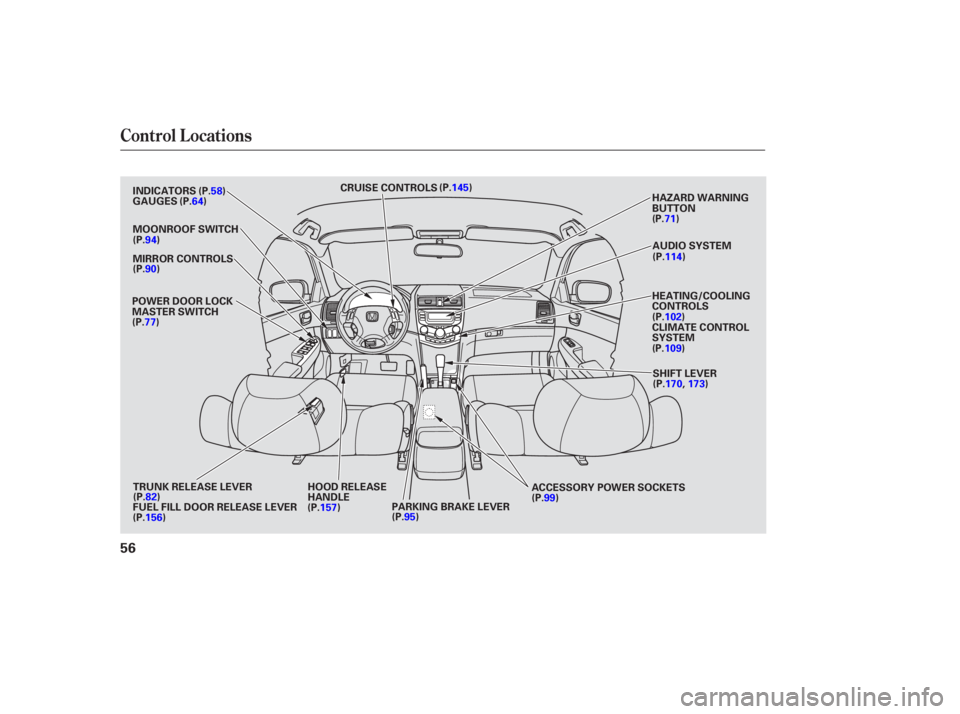
Control Locations
56
MIRROR CONTROLS
ACCESSORY POWER SOCKETSAUDIO
SYSTEM
CLIMATE CONTROL
SYSTEM HEATING/COOLING
CONTROLS HAZARD
WARNING
BUTTON
CRUISE
CONTROLS
MOONROOF SWITCH
TRUNK RELEASE LEVER
PARKING BRAKE LEVER
HOOD
RELEASE
HANDLE
INDICATORS
GAUGES
FUEL
FILL DOOR RELEASE LEVER
POWER
DOOR LOCK
MASTER SWITCH
SHIFT LEVER
(P.58)
(P.64)
(P.94)
(P.90)
(P.77)
(P.82)
(P.156) (P.145)
(P.71)
(P.114)
(P.102)
(P.109)
(P.170, 173)
(P.99)
(P.95)
(P.157)
Page 58 of 293
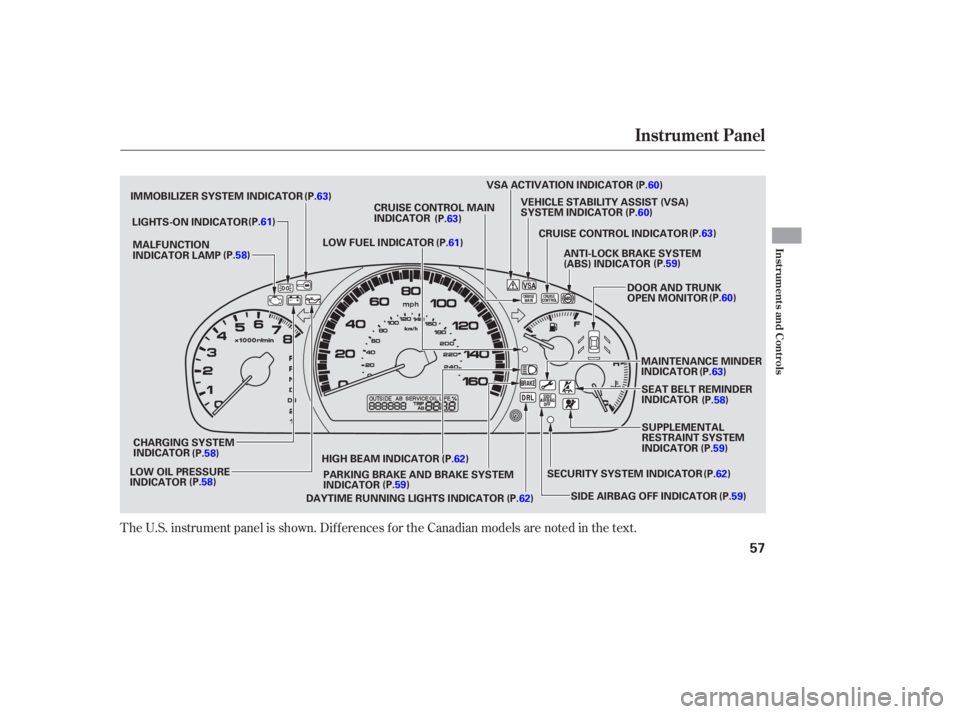
The U.S. instrument panel is shown. Differences for the Canadian models are noted in the text.
Instrument Panel
Instru me ntsand Cont ro ls
57
CRUISE CONTROL INDICATOR
LOW FUEL INDICATOR
MALFUNCTION
INDICATOR LAMP
LOW OIL PRESSURE
INDICATOR SECURITY
SYSTEM INDICATOR
IMMOBILIZER
SYSTEM INDICATOR
ANTI-LOCK BRAKE SYSTEM
(ABS) INDICATOR
SUPPLEMENTAL
RESTRAINT SYSTEM
INDICATOR
DOOR
AND TRUNK
OPEN MONITOR
CRUISE
CONTROL MAIN
INDICATOR
HIGH BEAM INDICATOR
(P.58) (P.58) (P.61)
(P.61)
(P.62)(P.60)
(P.63)
(P.59)
(P.63)
(P.62) VSA
ACTIVATION INDICATOR
(P.63)
(P.58)
CHARGING SYSTEM
INDICATOR VEHICLE
STABILITY ASSIST (VSA)
SYSTEM INDICATOR
PARKING BRAKE AND BRAKE SYSTEM
INDICATOR MAINTENANCE
MINDER
INDICATOR
DAYTIME RUNNING LIGHTS INDICATOR SIDE
AIRBAG OFF INDICATOR (P.59)
LIGHTS-ON
INDICATOR (P.60)
(P.59)
(P.60)
(P.63)
(P.59) (P.62) SEAT
BELT REMINDER
INDICATOR (P.58)
Page 59 of 293
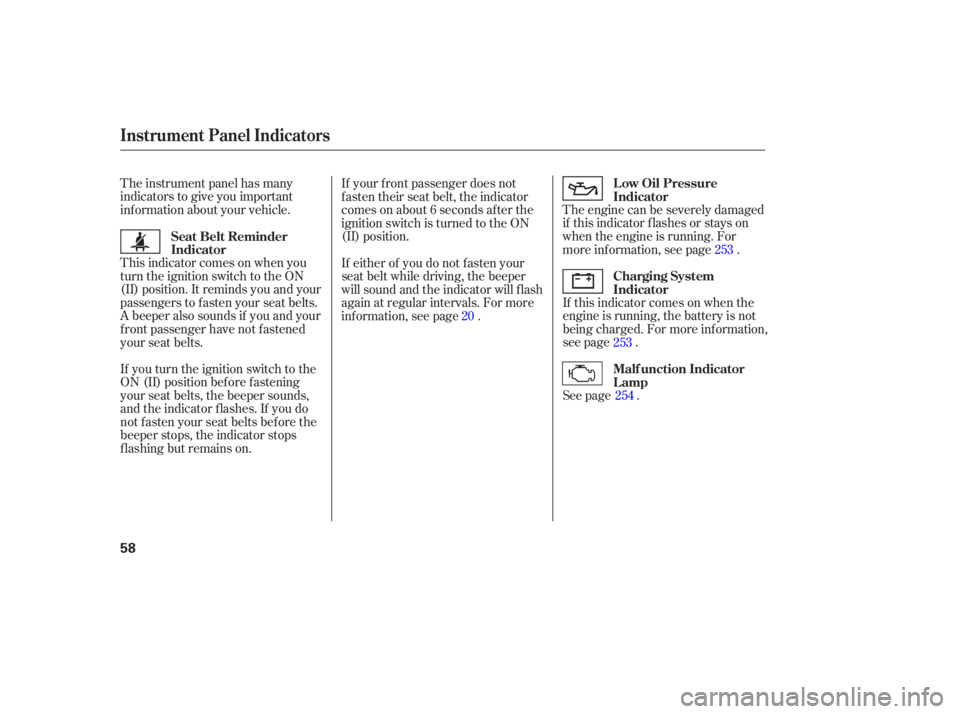
The instrument panel has many
indicato rs to give you important
information about your vehicle. The engine can be severely damaged
if this indicator flashes or stays on
when the engine is running. For
more information, see page .
If this indicator comes on when the
engine is running, the battery is not
being charged. For more information,
see page .
See page .
This
indicator comes on when you
turn the ignition switch to the ON
(II) position. It reminds you and your
passengers to fasten your seat belts.
A beeper also sounds if you and your
front passenger have not fastened
your seat belts.
If you turn the ignition switch to the
ON (II) position before fastening
your seat belts, the beeper sounds,
and the indicator flashes. If you do
not fasten your seat belts before the
beep er stops, the indicator stops
fl ashing but remains on. If
your front passenger does not
fasten their seat belt, the indicator
comes on about 6 seconds after the
ignition switch is turned to the ON
(II) position.
If either of you do not fasten your
seat belt while driving, the beeper
will sound and the indicator will flash
again at regular intervals. For more
inf ormation, see page . 20 253
253 254
L ow Oil Pressure
Indicator
Charging System
Indicator
Malf unction Indicator
Lamp
Seat Belt Reminder
Indicator
Instrument Panel Indicators
58
Page 60 of 293
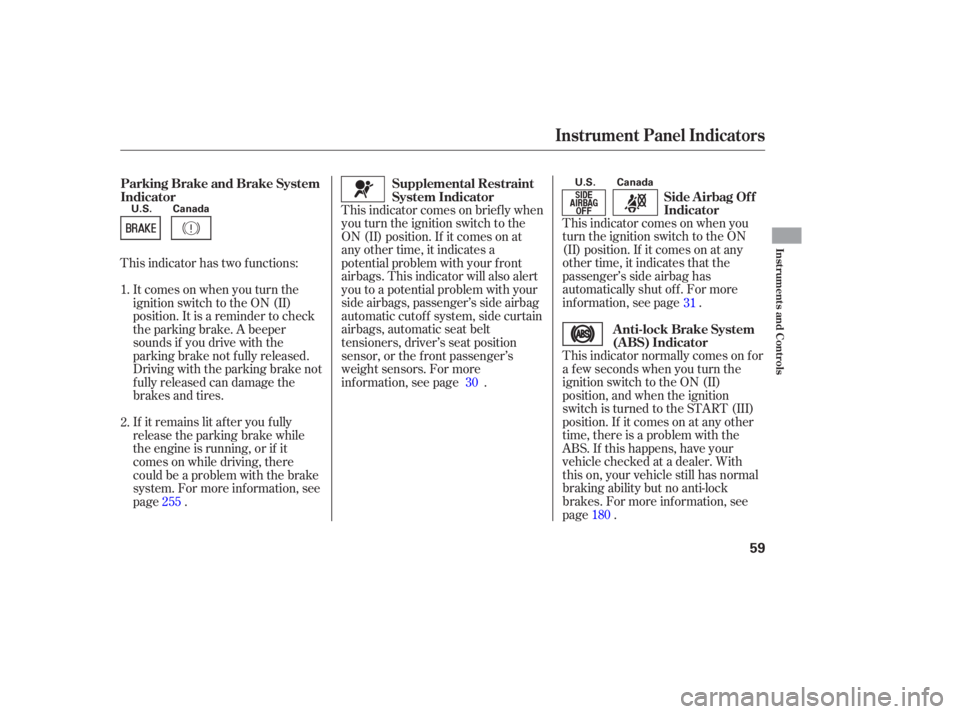
This indicator comes on when you
turn the ignition switch to the ON
(II) position. If it comes on at any
other time, it indicates that the
passenger’s side airbag has
automatically shut off. For more
info rmation, see page .
This indicator normally comes on for
a few seconds when you turn the
ignition switch to the ON (II)
position, and when the ignition
switch is turned to the START (III)
position. If it comes on at any other
time, there is a problem with the
ABS. If this happens, have your
vehicle checked at a dealer. With
this on, your vehicle still has normal
braking ability but no anti -lock
brakes. For more information, see
page .
This
indicator comes on briefly when
you turn the ignition switch to the
ON (II) position. If it comes on at
any other time, it indicates a
poten tial problem with your front
airbags. This indica tor will also alert
you to a poten tial problem with your
side airbags, passenger’s side airbag
automatic cutoff system, side curtain
airbags, automatic seat belt
tensioners, driver’s seat position
sensor, or the front passenger’s
weight sensors. For more
info rmation, see page .
This
indicator has two functions:
Itcomesonwhenyouturnthe
ignition switch to the ON (II)
position. It is a reminder to check
the parking brake. A beeper
sounds if you drive with the
parking brake not fully released.
Driving with the parking brake not
fully released can damage the
brakes and tires.
If it remains lit after you fully
release the parking brake while
the engine is running, or if it
comes on while driving, there
could be a problem with the brake
system. For more information, see
page . 30
31
1.
2.
180
255 Anti-lock Brake System
(A BS) Indicator
Supplemental Restraint
System Indicator
Parking Brake and Brake System
Indicator
Side Airbag Of f
Indicator
Instrument Panel Indicators
Inst rument s and Cont rols
59
Canada
U.S.
Canada
U.S.